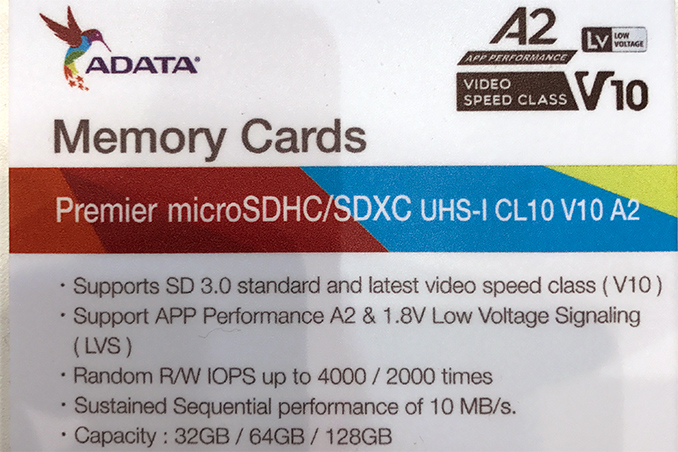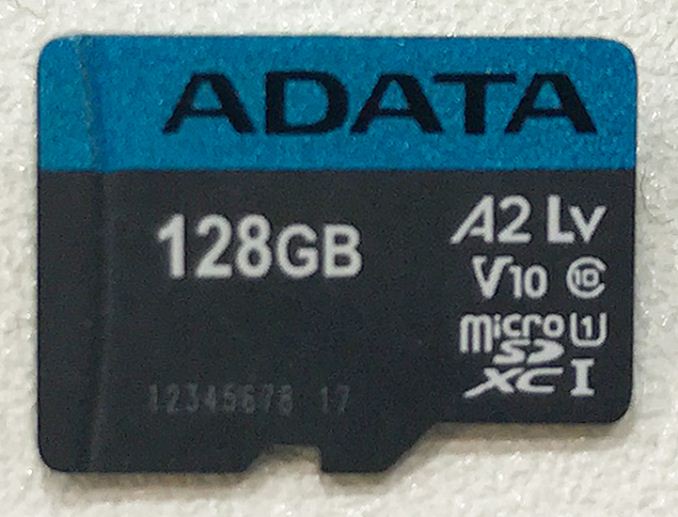ADATA Demos A2-class microSD Card with 4K/2K IOPS Minimum, Mulls Late 2017 Launch
by Anton Shilov on June 13, 2017 11:00 AM EST- Posted in
- Memory Cards
- ADATA
- Trade Shows
- SD cards
- Computex 2017
- A2

ADATA displayed its first microSD card that is compliant with the App Performance 2 (A2) specification introduced earlier this year at Computex. The company is mulling to release the card later this year, but this depends on availability of hosts that support features mandated by the A2.
ADATA’s lineup of A2-compliant Premier microSD cards will include 32 GB, 64 GB, and 128 GB models. The new cards will use the UHS-I bus with up to 104 MB/s sequential read/write speed, so do not expect extreme performance numbers from such devices. In accordance with the A2 requirements, the cards provide a random performance of at least 2000 write IOPS, at least 4000 read IOPS as well as sustained sequential read/write speed at 10 MB/s (which is why the cards also carry the V10 badge).
However, guaranteed minimum performance figures are not the only requirements of the A2. All cards carrying the A2 label are mandated to support such functions as command queuing (with a minimum depth que of 2 and a maximum depth que of 32) to optimize random read performance, caching to hit write performance targets, as well as 'self-maintenance' features and low-voltage signaling (LVS). To support all the additional A2 functionality, the new SD cards need appropriate controllers and support from hosts. As you can likely guess, ADATA does not disclose supplier of its controllers, but the fact that the company is showing the card indicates that at least some suppliers are already sampling appropriate ICs.
| Preliminary Specs of ADATA Premier A2-Compliant microSD Cards | |||||
| 32 GB | 64 GB | 128 GB | |||
| Form-Factor | MicroSDHC/SDXC | ||||
| NAND Type | unknown | ||||
| Read Speed | Up to 104 MB/s | ||||
| Write Speed | Up to 104 MB/s | ||||
| Random Read IOPS (Minimum) | 4000 | ||||
| Random Write IOPS (Minimum) | 2000 | ||||
| Sustained Sequential Read/Write Speed (Minimum) | 10 MB/s | ||||
| Interface | UHS-I | ||||
| Availability | Late 2017 - Early 2018 | ||||
| SDA Labels | UHS-I, A2, LV, Class 10, U1, V10 | ||||
For example, Silicon Motion is sampling its SD 6.0-compliant SM2705EN and SM2707EN controllers that support command queuing, caching, self-maintenance and low-voltage signaling (LVS). The aforementioned controllers are compatible with 3D MLC/3D TLC memory and feature Silicon Motion's DuoECC engine with improved data correct ability (given the application, it is logical to assume that we are dealing with a BCH-based ECC, but we have not confirmed that).
Besides controllers, A2-compliant SD cards have to be supported by hosts and this is concern for hardware makers (including ADATA and SMI). In particular, command queuing and caching features have to be supported by hosts and currently there are no hosts that support CQ and caching for SD cards.
ADATA is currently planning to release the Premier microSDHC/SDXC UHS-I CL10 V10 A2 LV cards either late in 2017 or in early 2018, depending on various factors, including support by hosts. Pricing is something that the company will determine closer to the launch.
Related Reading:
- SD Association Announces UHS-III (up to 624 MB/s), A2 Class, LV Signaling
- ADATA Launches Premier ONE UHS-II SD Cards: 3D MLC, Up to 290 MB/s, V90 Labels
- ADATA Demonstrates 256 GB microSDXC Card
- Patriot Introduces LX 256 GB microSDXC Card with Class 10, U3 Certifications
- The SD Card Association to Classify IOPS Performance of Memory Cards via Logo
- SD Association Announces SD 5.0 Specification: SD Cards For UHD and 360° Video Capture
Source: ADATA











10 Comments
View All Comments
XZerg - Tuesday, June 13, 2017 - link
The last image has contradicting information:4k/2k iops in the points
40k/20k iops in the table
HomeworldFound - Tuesday, June 13, 2017 - link
It says that it meets A2 (App Performance Class 2) requirements of 4K/2K.The table lists the cards actual random performance.
extide - Tuesday, June 13, 2017 - link
Holy crap, what is wrong with the SD association. Why do people need to concern themselves with so many standards, I mean seriously, " microSDHC/SDXC UHS-I CL10 V10 A2 LV" that is ridiculous. Why can't they keep it more simple.MajGenRelativity - Tuesday, June 13, 2017 - link
You make a good pointdstarr3 - Tuesday, June 13, 2017 - link
The idea is to make manufacturers clutter up the labeling on MicroSD cards so badly that there's no room left for branding. We're almost there!MajGenRelativity - Tuesday, June 13, 2017 - link
Oh wow, I didn't realize that. Let's make even more standards then!mkozakewich - Wednesday, June 14, 2017 - link
Because people make mistakes. The whole "Class 10" thing is stupid today, because getting 10 MB/s with an SD card is just terrible. It's still on there, though.Meanwhile, we've got a bunch of standards that focus on different things, like sequential speeds for video or random IO for applications. (Frankly, I wish they'd be given dual grades based on 4K random and sequential, and just leave it at that.)
SharpEars - Wednesday, June 14, 2017 - link
Sustained sequential performance of 10 MB/s, woohoo!!! /sSantoval - Wednesday, June 14, 2017 - link
I don't understand why they would use the very slow UHS-I bus when UHS-III was already completed.. Why not use at least UHS-II? So, higher random performance but low capped maximum sequential performance? Business segmentation strategy?mkozakewich - Wednesday, June 14, 2017 - link
Higher compatibility.